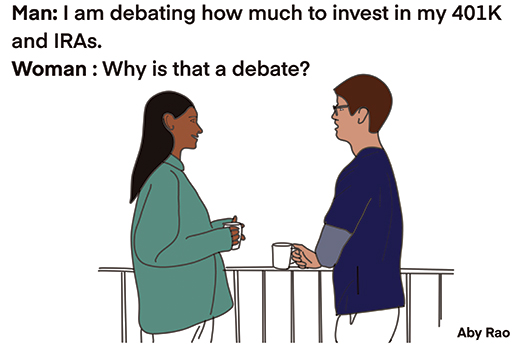
One commonly asked question is what assets should be chosen to invest in two different categories, namely taxable and non-taxable groups. There are some limitations on non-taxable assets (IRAs, 401Ks, 403b etc.) as to what and where we can invest under that umbrella. Non-taxable assets cannot be invested in collectibles like art, automobiles and more, life insurance contracts and derivative trades, and there are other restrictions as well.
There is no such restriction on taxable accounts but some of those are still not recommended.
There are major differences between the two classes, and we need to recognize those first. As the title suggests, non-taxable assets are the ones for which you have not paid income taxes, either on the principal or on the earnings or both and you pay those taxes only when you withdraw from those accounts (except ROTH accounts).
Generally, per IRS’s rules today, you must wait till your age of 59.5 before you can withdraw from them without penalty, but you always have to pay income taxes whenever you withdraw. There are some exceptions, like you can withdraw from that account up to $10,000 if you are buying your first house and there are few other exceptions for penalty free withdrawal but still not tax free.
There is also a special provision where if you wish to retire at 55, you can start withdrawing at that age if you can continue to withdraw at a steady rate from that point onwards.
 Investing in non-taxable should be a long-term or a very long-term strategy depending on your age. If you are just starting your work life, say in your early 20s, then you have at least 35 to 40 years in front of you where these funds will keep growing untouched and unimpeded. That is a very long-term perspective and that is exactly how these accounts should be treated. In most cases you cannot or do not wish to withdraw from these accounts and really, you would want them to grow at the highest rate possible; inside such accounts one can buy/sell, earn interests/dividends or anything else and it is not a concern to the owner.
Investing in non-taxable should be a long-term or a very long-term strategy depending on your age. If you are just starting your work life, say in your early 20s, then you have at least 35 to 40 years in front of you where these funds will keep growing untouched and unimpeded. That is a very long-term perspective and that is exactly how these accounts should be treated. In most cases you cannot or do not wish to withdraw from these accounts and really, you would want them to grow at the highest rate possible; inside such accounts one can buy/sell, earn interests/dividends or anything else and it is not a concern to the owner.
The most common thought that is expressed by many is what if there is a recession and “my IRA value goes down?” Yes, that is possible but if I go by the experience of the numerous previous recessions, they all come back with some vengeance within three years, if not sooner. Since these are locked-up accounts, you cannot do anything anyway and quite frankly there is no need to do anything; let your value ride with the market and you will be glad that you did not panic and sold things at the wrong time. This is somewhat akin to the price of your house which you own and where you live; when the markets are down there is not much one can do except go with the flow.
Now the new SECURE II law has taken the age limit to 73 (or 75 in 2033) for an RMD withdrawal and hence the 35/40-year period is extended even further. Depending on what you and your spouse’s risk tolerance is you can decide at what level of aggressiveness you can invest; but know that time is on your side. One thing for sure, all the withdrawn money, whenever that happens, from a non-taxable account will be taxed at your regular income tax rate, whatever it may be at the time. If you wait ’til 73 (or 75) to start taking the withdrawals (RMDs) then you must give serious consideration to IRMAA Medicare premium charges, which are substantial.
What is IRMAA?
The Medicare income-related monthly adjustment amount, or IRMAA, is a surcharge on Medicare premiums for Medicare Part B (medical insurance) and Part D prescription drug plans. It applies only to Medicare beneficiaries who have a modified adjusted gross income above $97,000 for an individual return and $194,000 for a joint return. If your earnings are below this threshold, IRMAA doesn’t apply to you.
Taxable assets are a different story. Every year you earn interest/dividends or sell stocks and earn some capital gains or any which way you earn profits you will have to declare and pay income taxes on them when you file 1040 for that year; you must earn that profit by selling. So, this tells us two things right away. Buy stocks that you wish to keep for a long time and ideally you would want to buy stocks that grow well but do not pay dividends; such stocks are not that easy to find but they are there. Apple, Google and Amazon were all like that but after the first 15 years or so they fell prey to paying dividends.
Another important aspect to remember is that long-term capital gain taxes are capped at 20 percent (but generally 15 percent which is much less than regular income tax you might pay) and there are no capital gain taxes for married filing jointly if their taxable income is below $89,250 for year 2023. If the person can wait till the assets are transferred upon his/her death, then the cost basis is updated to the market value on that day and there are no capital gain taxes if the inheritor sells immediately after.
After reading how taxation happens in the cases of non-taxable and taxable accounts you know, by now, what policy you wish to follow. I would think that the goal must be to minimize the income taxes in both cases. I will say this that if your income is reasonably high in retirement or will be high at the time of retirement say at 65, then you must take into consideration the IRMAA impact on your Medicare premiums. Everyone who is close to age 60 and dreaming of comfortable retirement needs to do some advance planning and determine if there is a way to undermine IRMAA impact.
That thought takes us back to the split of our assets between taxable and non-taxable. The goal should be to reduce adjusted gross income, which is what IRMAA looks at. For non-taxable there is a withdrawal procedure but for taxable there is none. Careful planning of both assets is almost a must.
Mo Vidwans is an independent, board certified financial planner. For details visit, vidwansfinancial.com, call 734-476-0579 or write to: mvfinancial@yahoo.com



